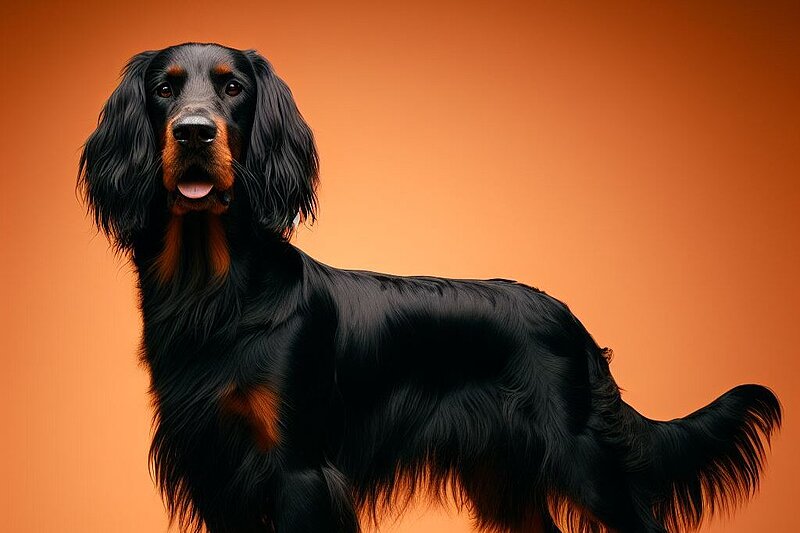The Gordon Setter: elegance in black and brown
History and origin
The history of the Gordon Setter begins in Scotland in the 17th century. Originally, these dogs were bred to hunt on the Duke of Gordon's estate. The Duke of Gordon, Alexander, was a passionate hunter and was looking for a dog that was both enduring and intelligent. He crossed different breeds of hunting dogs, including the Bloodhound and the Black and Tan Terrier, to create the perfect companion for hunting birds. The result was the Gordon Setter, known for its ability to track down and collar game.
Who is the Gordon Setter suitable for?
The Gordon Setter is ideal for active people or families who spend a lot of time outdoors. These dogs are full of energy and love to move around. They are excellent companions for runners, hikers and hunters. Because they need a lot of exercise, they are less suited to city life or small apartments. A house with a large garden is perfect for this breed.
Character and temperament
The Gordon Setter is a friendly and affectionate dog that bonds closely with its family. They are known for their loyalty and protective instincts. Gordon Setters are intelligent and eager to learn, but also independent and sometimes stubborn. They are social and get along well with other dogs and pets when properly socialized.
Appearance of the Gordon Setter
The Gordon Setter is a striking dog with a distinctive black and brown coat. The coat is of medium length, dense and can be slightly wavy. The chestnut-brown markings on the paws, chest and face are typical. They have a strong build, with well-developed muscles and an elegant gait. Their ears are medium-sized and droopy, and their eyes radiate intelligence and friendliness.
Grooming and health
Coat care
The Gordon Setter's coat requires regular grooming to prevent matting. Thorough brushing once or twice a week is sufficient to keep the coat healthy and shiny. More frequent brushing is required during the shedding season in spring and fall. Ears and eyes should be checked and cleaned regularly to prevent infections.
Exercise and exercise
The Gordon Setter needs plenty of exercise. Daily, extended walks and the opportunity to run free are a must. These dogs are particularly suited to active outdoor activities such as hiking or playing fetch. They only feel comfortable in the city if they get enough exercise and activity.
Training
Gordon Setters are intelligent dogs that love to learn, but they can also have a headstrong character. Consistent, positive training is the key. Early socialization and obedience training are important to have a well-behaved dog. Training methods should be varied and motivating to keep the dog interested.
Health and life expectancy
Gordon Setters are generally healthy dogs, but can be prone to certain genetic diseases. Hip dysplasia, progressive retinal atrophy and hypothyroidism are some of the health problems that can occur in this breed. Regular veterinary check-ups and a balanced diet are important to ensure the dog's health. The life expectancy of a Gordon Setter is between 10 and 12 years.
Size and weight
Gordon Setters are medium to large sized dogs. Males reach a shoulder height of 61 to 66 cm and weigh between 29 and 36 kg. Females are slightly smaller, with a shoulder height of 58 to 63 cm and a weight of 25 to 32 kg.
Interactions with children and other animals
Gordon Setters are friendly and patient dogs that get along well with children. They are playful and enjoy being part of family activities. Their social nature also makes them good companions for other dogs and pets, provided they have been trained from an early age.
FCI recognition
The Gordon Setter is recognized by the Fédération Cynologique Internationale (FCI) and belongs to Group 7: Pointing Dogs, Section 2: British and Irish Pointing Dogs. This recognition underlines the importance and uniqueness of this breed in an international context.
